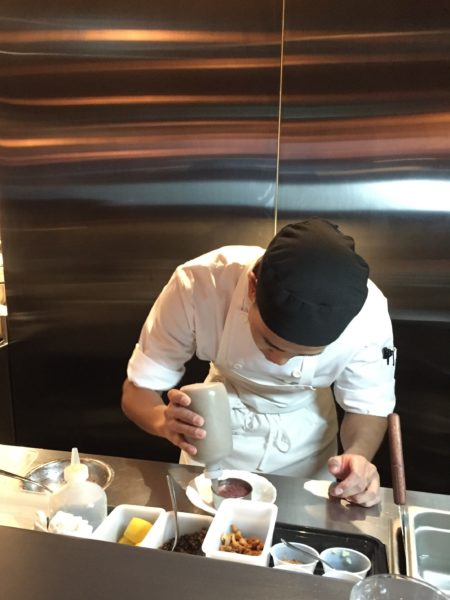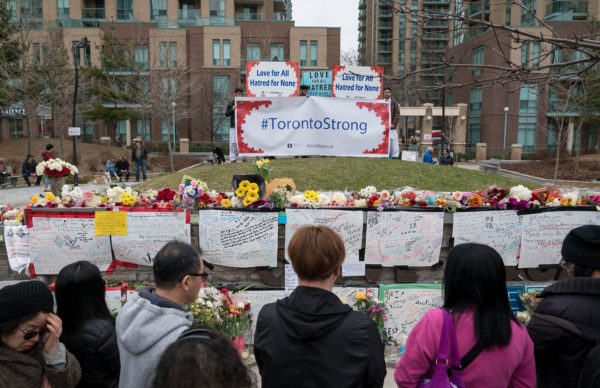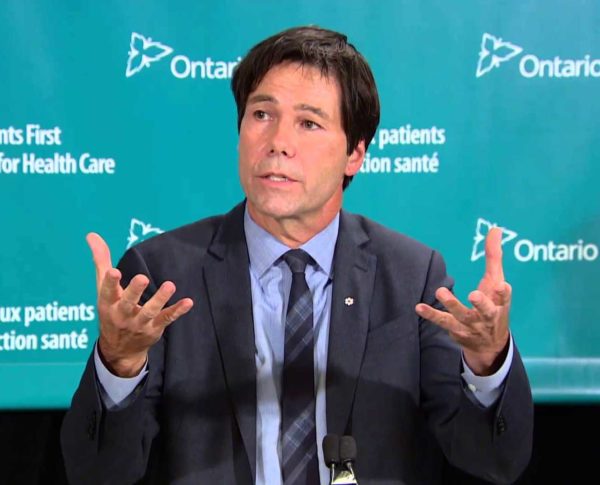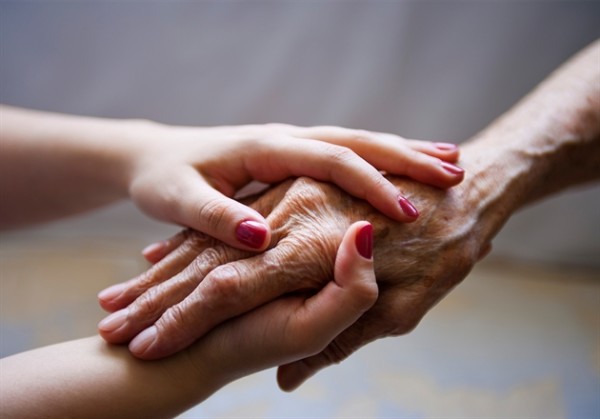
I’ve been a fan of award-winning restaurant Alo since its opening about three years ago. With the opening of its latest offshoot – Alobar Yorkville located at 162 Cumberland Street in the heart of Toronto’s most upscale neighbourhood – the burgeoning Alo brand is surely expanding at a rapid rate.
By now, Alo Restaurant is at the apex of every single “best Toronto restaurants” and “best Canadian restaurants” list. It has also recently won the internationally-renowned Relais & Chateux designation and is the only Canadian restaurant ranked on the 2018 list of the World’s Best 50/100 Restaurants. Building on the flagship brand’s success and accolades, its “bistro/diner” sister establishment, Aloette, was opened last year followed by the newest family member, Alobar Yorkville, two weeks ago.
Alobar positions itself as “a cocktail bar as well as a full-fledged restaurant offering choice seafood with the finest accoutrements, fish and chops off of the charcoal grill, and world-class wines, all served with genuine hospitality” on its website. My first dining experience there was excellent as my friend and I were seated at the only two bar stools facing the open kitchen (the rest of the bar stools face the bar). I loved the hamachi, tuna tartare and foie gras appetizers, and my Pacific Cod as an entree was heavenly. Alobar is a classy and sophisticated combination of the food at the original bar of Alo Restaurant and the open kitchen “performance” at both Alo and Aloette. The banquette table arrangements at Alobar also reminded me of the seating at Alo. The room was decorated with an understated elegance and the vibe was lively, attracting primarily a boomer clientele.
I’ve also read from the website of Canada’s 100 Best Restaurants that Alobar features a Josper oven, a Spanish-made combination oven and grill powered exclusively by charcoal. Apparently, Jospers are de rigeur at the best tapas bars, grill rooms and grill-friendly fine-dining establishments across Europe and Asia. They are ultra expensive and there are only a few restaurants in Canada who have such an installation best used for grilling vegetables, fish or beef. Alobar has only 50 indoor seats and without any opening fanfare, the new restaurant is already sold out for at least a week in advance.
In terms of branding, I think Chef Owner Patrick Kriss is spot-on with his three restaurants. Alo is the flagship fine-dining brand – exclusive, sophisticated, world-class, and almost inaccessible with a two-month advance booking requirement and long wait lists. Right below Alo on the ground floor is Aloette, the sub-brand that is almost the opposite of Alo – accessible, very casual, and fun with no reservations required. Now comes Alobar Yorkville, the intermediate sub-brand – elegant, smart casual, intimate and vibrant – located in one of the most exclusive and chic neighbourhoods in Toronto. But all three brands share the same consistent qualities that have earned Kriss his accolades: attention to detail, excellent food and service, and beautiful ambiance.
I have shared with Chef Kriss in person what I think is his most distinct unique selling proposition that differentiates the Alo brand from the competition – the stellar quality of his people. Never have I seen elsewhere a team who absolutely shares Kriss’s vision and values for the Alo brand in everything they do. From the kitchen to the servers to the mixologists to the reception to the managers, everybody shares the same strong passion to deliver excellent service, genuine and warm hospitality, and an unforgettable experience for the customers in all three restaurants. In fact, the Alo group of restaurants are the only eateries in Toronto where I would not hesitate to leave a well-deserved 20 percent service gratuity when the bill comes.
Kudos to Kriss who not only has discerning eyes for recruiting the best people, but also has the foresight to help his team grow with him and his business. I’ve noticed him promoting high performers whenever possible from within the organization which is always the most effective way to retain talents. Customers frequent any of the three Alo restaurants not just because of the delicious food, but also the same consistent experience that they deliver during each visit. It remains to be seen whether Chef Kriss’s ambition and vision would take him beyond Toronto and even around the world similar to what Daniel Boulud, David Chang, Jean-Georges Vongerichten and Joel Robuchon have accomplished. But Chef Kriss is still young and, for now, his star is very bright in the culinary and hospitality firmament!
]]>

Photo Credit: The Globe and Mail
Because of my former profession as a communications consultant, it is only natural for me to remain a news junkie even after my retirement. The media coverage of the recent van-attack tragedy that happened in Toronto on a beautiful Monday afternoon showed the real mettle of good journalism. The best media outlet, in covering tragedies, would be one which was not only able to be first, but also accurate and compassionate at the same time without unnecessary sensationalism.
The Globe and Mail claimed that it was not the first media outlet to report the number killed in the Toronto van rampage on April 23. Nor was it the first to report on a Facebook page purportedly operated by the suspect Alek Minassian that referred to dark online forums used by trolls and violent misogynists. But it claimed that the publication focused on getting the correct information. This might be true, but when all print media now also have digital versions, the speed of reporting is almost as important as the accuracy.
I did not find out about the tragic news until about 4 p.m. that afternoon, and I immediately relied on CP24 for the latest news. The live news conference quickly put together by the Toronto police at around 4:30 p.m., involving the Deputy Chief Police Commissioner Peter Yuen and representatives from the three levels of government, was impressive as it pretty much summarized what the tragedy was all about and what the casualties were. At that early hour, we still did not know the name and motive of the alleged killer nor the identities of the victims. But the most important reassurances have been delivered: although nine lives were claimed at that time, the over 15 injured victims were frantically being helped at Sunnybrook Hospital which declared Code Orange for its emergency department; condolences were conveyed on air by the police and government officials; the public was asked to stay away from the stretch of Yonge Street from Finch to Sheppard in order to allow the police to carry on with the investigation; a suspect was arrested by a brave traffic cop without a gunfire being shot. What was most reassuring was that the Federal Minister of Public Safety Ralph Goodale informed everyone that this tragedy did not appear to be one that would threaten national security.
Under such circumstances, I was glued to my TV set while glancing at numerous social media feeds to get the latest updates. After watching all the national news networks – Global News from 5:30 p.m. to 7 p.m. followed by CBC News and CTV News that evening – CTV News was the first to report on the name of the arrested suspect and his identity as a Seneca College student. CBC The National was the first media outlet to confirm a Facebook post by the suspect shortly before he started the van rampage. This post unveiled the digital trail which indicated that the suspect could have been motivated by the misogynist hate group INCEL (involuntary celibates). When Police Chief Mark Saunders gave the second live update news conference on CP24 later that evening upon his return from New York City, he was already able to update the public that the death toll had by then climbed to 10 and the name of the suspect was also disclosed although the first name was mistakenly given as Alex instead of Alek.
The Facebook post was actually already reported much earlier than the evening news by numerous social media. However, nobody in their right minds could have believed these sources and verified whether they were true stories or fake news. So CBC was not the first to report on the Facebook post and the INCEL association, but they were the first to confirm that this rumor on social media was true and they verified that with Facebook as well before reporting on the news. CTV News was the first to confirm the name and identity of the arrested suspect via their Ottawa reporter which surprised me.
Kudos to CTV and CBC for fast and accurate breaking news. I was disappointed with Global TV News not only because they were not able to be the first, but also because of the lack of empathy in the reporting. Although one news anchor was covering the tragedy live on Yonge Street and the other in the newsroom, neither one of them showed grave concern on their faces. Instead, the ambulance-chasing attitude and goofiness on air were major turnoffs.
After the initial shock and update on the first day of the tragedy, my attention was then turned to the print media on the second day to see which reporter or media outlet was able to give the best in-depth report. The best reporting prize on the aftermath, in my opinion, should go to John Ibbitson of The Globe and Mail, whose article, The Truths Canada Needs To Remember, was a beautiful commentary on the attack that brought tears to my eyes. As he wrote, “We will remember that violence against the innocent brings out the best in Canadians, not the worst….What matters is, once again, we have collectively been wounded. And, collectively, we will heal, as we have healed in the past, by mourning and supporting, rather than accusing…We are not going to let anyone take our peaceful, free, diverse, safe streets away from us.”
Amen!
]]>

I have more than once advocated the support of a national pharmacare program for Canada on this blog. It, therefore, gave me hope when the Trudeau Government recently plucked Ontario’s Health Minister, Eric Hoskins, to chair a special Federal Commission to look into the introduction of a national pharmacare program for the nation. Yesterday, Ontario Premier Kathleen Wynne said that her budget will include a blueprint to expand Ontario’s pharmacare program, known as OHIP-plus, which currently covers people up to the age of 25. She said she will move forward without the federal government for now and beginning August 1, 2019, seniors will no longer have to pay a deductible or co-payment for more than 4,400 prescription drugs.
Skeptics immediately said that both the Federal and Ontario Liberal Governments made these promises to win votes in the upcoming elections. For the highly unpopular Kathleen Wynne, in particular, this is obviously a campaign promise to woo the votes of the boomer and senior populations. She says the program will cost $575 million a year when it is fully operational in 2020-21. Drugs covered in the program include medications for cholesterol, hypertension, diabetes and asthma. Campaign promises can be broken but this latest announcement has won my vote.
Health care ranks highly among voter concerns in national polls, so it did not surprise me when Finance Minister Bill Morneau introduced the feasibility study of a national pharmacare program when he unveiled the Federal budget last month. The budget announced the creation of an advisory council, headed by Dr. Eric Hoskins, that would investigate whether public health-insurance plans could be expanded to cover prescription drugs. A national pharmacare plan had been previously proposed by the New Democratic Party (NDP).
The appointment of Dr. Hoskins, in itself, is already a step in the right direction. Dr. Hoskins, while in office as Ontario’s Health Minister, has always been a strong advocate for a national pharmacare program. In his new role, he will study the options, their costs, explain the trade-offs and determine which is the most feasible. Currently, about 26 million Canadians have private drug benefits, largely through employers. There are 102 public drug insurance programs, but that still leaves 700,000 people with no drug coverage, and an estimated 3.6 million with inadequate coverage, according to the Parliamentary Budget Officer.
A national pharmacare plan could save anywhere from $4 billion to $11 billion on the $28.5-billion prescription drug bill (from 2015). These savings could come from joint buying, more strictly regulating drug prices, more aggressive use of generics, and limiting the list of drugs that are covered. The Globe and Mail reported that while a single, national plan would theoretically save money on drug purchases, it would also mean a large-scale shifting of costs from the private sector to the public sector. The single biggest obstacle to pharmacare is the unwillingness of federal, provincial and territorial governments to absorb those costs and then increase taxes to pay the bill.
National pharmacare means insuring that every Canadian has access to necessary prescription drugs regardless of ability to pay. This philosophy has very few detractors, but there are many technical, financial and political impediments. But the appointment of Dr. Hoskins to chair the advisory council suggested the government’s seriousness about this initiative. It is well known that Dr. Hoskins, a physician himself, is a long-time proponent of an ambitious national pharmacare program. He has publicly backed that the best way of doing pharmacare is to throw out the system we currently have. The basic idea is that medically necessary drugs would be covered under the Canada Health Act and provided by provincial health plans for everybody, including those who now have private insurance. The federal government’s bulk-buying power would drive down prices for these new plans. People who felt the public coverage was inadequate could buy supplementary insurance on the private market, just like they can under medicare.
Skeptics and the Opposition are already criticizing the Trudeau government for paying lip service. But given Dr. Hoskins’s credentials and track record, and the timing of the Federal elections next year, it will only work to the Liberals’ advantage to devise a fiscally-responsible national pharmacare plan that would work.
Judging from the latest national polls, the Federal Government seems to be on the right track. A new Nanos Research poll that surveyed 1,000 Canadian adults by phone and online between March 7 and March 12, after the Liberals tabled their third federal budget on February 27, indicated that Canadians support the idea of public health insurance that covers prescription drugs. But they don’t like running deficits nor do they want new taxes to pay for the programs. But Canadians cannot have their cake and eat it too! How will the national pharmacare program be paid for otherwise? The NDPs have not come up with a good idea for financing this program either. So we should let Dr. Hoskins do his job and come up with a sensible plan. In Canada, we have had public hospital insurance since 1957, and public insurance for physicians since 1966. It is about time that we see another large-scale national health initiative on the horizon.
]]>
Photo Credit: ehospice.com
While everybody has been debating about the pros and cons of the proposed Bill C-14 on the right to die in Canada, another important topic is being sidelined – the access to and the quality of palliative care.
Specialists believe that there is too much fear surrounding discussions about end-of-life care. They said it is not about what happens when all treatments have failed, but a team of people – such as doctors, nurses, social workers and others – helping make sure Canadians have what they need to continue fighting while relieving the severity of symptoms and improving quality of life. According to palliative care experts, part of the challenge is that there will be legislation around the right to assisted death but there is neither legislation nor enough clinicians to adequately provide end-of-life care across Canada.
Dr. Jeff Myers, the head of Palliative Care at Sunnybrook Health Sciences Centre in Toronto, believes end-of-life care should be provided by family doctors, specialists and many other health care professionals who are already treating people for disease. This includes basic symptom management, emotional and mental health support, and the ability to discuss advance care planning and goals of care. He said then we can be certain that people are making assisted dying requests having had access to the full spectrum of care, regardless of how long they have left to live and regardless of what challenging conditions they are living with.
Another end-of-life care expert, Harvey Max Chochinov, who is Canada Research Chair in Palliative Care and Director of the Manitoba Palliative Care Research Unit, wrote in The Toronto Star last year that despite the impressive strides that palliative care has taken, physicians have been taught less about pain management than those graduating from veterinary medicine. Once in practice, most physicians have knowledge deficiencies that can significantly impair their ability to manage cancer pain. Doctors are also not generally well-trained to engage in end-of-life conversations, meaning that goals of care often remain unclear; and patients may not receive the care they want or the opportunity to live out their final days in the place they would want to die.
According to Professor Chochinov, it is unfortunate that for 70 to 80 percent of Canadians, palliative care is not available and, therefore, not a real choice. It is concerning that we might become a country that extends patients the right to a hastened death, but offers no legislative guarantees or assurances that they will be well looked after until they die.
Palliative care doctors are urging the Canadian government to improve and standardize end-of-life care across the country. According to Dr. David Henderson, President of the Canadian Society of Palliative Care Physicians, there is a lack of palliative care service and it is unevenly distributed. In Canada, the federal government provides guidelines on health services and funding, but the provinces and territories manage them. Palliative care doctors would like to see one body set up to decide what are best practices in end-of-life care, how to mobilize them and set standards, and to collect data. Dr. Henderson said there needs to be palliative care training for new doctors and other health care workers as well as upgrading of skills for those already practicing. Fewer Canadians might opt for doctor-assisted death if palliative care services were improved.
Dr. Henderson also recently co-wrote in a Globe and Mail op-ed article with Dr. Susan MacDonald, Past President of the Canadian Society of Palliative Care Physicians, that while Bill C-14 is in the process of becoming law, palliative care units in Ontario are closing due to funding cuts, and there is no law on the table about the right to end-of-life care. Tragically, many people die at home, with no access to palliative care supports such as home care nursing or visits from a family doctor or, when needed, a palliative care team.
The two doctors strongly advocated that now is the time for a national palliative-care program. “Dying is a part of life,” they said. “We should not let our incomes, our postal codes or our family support networks determine how well or how poorly we die. We need to think about this, discuss it – and fix it. The time is right to insist that our health ministers address this issue in Canada’s new health accord.”
Too much focus has been placed on the June 6 deadline for passing Bill C-14, but not enough discussions have been made on understanding the urgency of universal access to quality palliative care in Canada. As the nation debates its response to the court’s decision, it is, perhaps, equally important for federal and provincial governments to make sizable investments in hospice and palliative care in order to offer patients and families choices that are fair, compassionate and real.
]]>

Photo Credit: Getty Images
As a staunch supporter of Uber, I was overjoyed to hear that Toronto finally joined Edmonton and Ottawa in legalizing Uber. Kudos to both Mayor John Tory and Uber’s own tireless efforts to rally all loyal supporters, riders and drivers. After months of protests, turmoil and, at times, violence, Toronto city council approved new rules in a marathon meeting last week that finally allowed a legal, regulated UberX to continue operating in Canada’s largest city.
Mayor Tory convinced council to vote 27-15 in favour of the following new rules:
- Allow private transportation companies like Uber to operate in Toronto, booked only through a smartphone app, with a $3.25 minimum fare (Uber will pay $0.30 per trip as a “city fee”) and “surge” peak-time pricing.
- Allow taxis to adopt a “surge” peak-time pricing for rides booked via smartphone app.
- Uber cars are not allowed to be hailed on the street. Taxi rides that are hailed on the street, at a taxi stand or ordered over the phone, still face regulated rates set by the city with no “surge” pricing.
- Taxis will continue to be required to have cameras, and flashing emergency lights, but not for Uber. Have city staff report back next year on whether private transportation companies like Uber need cameras.
- Ensure Uber and taxis have insurance of at least $2 million on all drivers for bodily injury, death and damages to people or property.
- Undo 2014 reforms that would have phased out ownership of “standard” plates as a commodity and ensure all cabs be accessible for disabled by 2014.
- The city will eliminate its requirements for drivers to take training programs in order to get a licence; and taxi and limousine drivers will no longer have to take CPR and first-aid training.
As a consumer who frequently relies on taxi and Uber rides, I believe the city has struck a right balance. We continue to have value-for-money ride-sharing services and with the new rules, passengers’ safety is safeguarded with the stipulation of insurance for Uber. While most passengers do not like “surge pricing,” we still maintain the option of calling a cab by phone or hailing one on the street.
Of course, the new legislation is not perfect and grey areas continue to exist. I would prefer Uber vehicles to be mandated to install cameras in order to ensure safety for passengers. There does not seem to be tightened legislation on criminal background checks on Uber drivers and this still puts thousands of ride-sharing passengers in some sort of danger.
Taxi drivers are obviously not happy because they now officially face stiff competition. While Uber’s spokesperson in Canada said they can live with the new rules, they also expressed concern that higher expenses would discourage part-time drivers to join Uber as it would be challenging to maintain a sound livelihood with the new system.
But, all in all, this is a good, solid confirmation of democracy and a freedom of choice for the fourth largest city in North America. Mayor Tory and city council should be lauded for listening to consumers and embracing new technology; striking a reasonable balance between taxi companies and ride-sharing services; paving the road for the advent of more ride-hailing companies such as Lyft; and making a commitment to review and adapt the rules and legislation pertaining to ride-sharing in a year’s time.
]]>